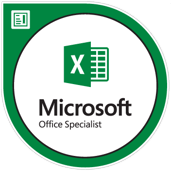Computer Applications | High School | Microsoft Office | Microsoft Office Specialist (MOS)
What Is the MOS Excel Associate Certification and How Is It Structured?
Coming from a family of educators, Brad knows both the joys and challenges of teaching well. Through his own teaching background, he’s experienced both firsthand. As a writer for iCEV, Brad’s goal is to help teachers empower their students by listening to educators’ concerns and creating content that answers their most pressing questions about career and technical education.
The MOS Excel Associate certification is the only Microsoft-recognized foundational Excel certification in the world.
When students earn the certification, Microsoft acknowledges their proficiency in using Excel.
Because many employers look for this proficiency in a variety of positions, earning an MOS Excel certification will prove a candidate has those skills. For this reason, many computer teachers across the country incorporate the certification into their classes.
But how do you know you’re teaching the right information to help your students pass the MOS Excel Associate exam?
In this article, you’ll learn the details of what’s covered by the MOS Excel Associate exam and some tips to prepare your students for test day.
We’ll focus on the Microsoft Office Specialist Excel Associate 2019/365 Exam (Exam MO-200) because it’s the most current version of the Excel certifications at the time of publication.
With that, let’s get into the details of the MOS Excel Associate certification exam!
How Is the MOS Excel Certification Exam Structured?
The MOS Excel Associate 2019/365 exam proves students have mastered data analysis, manipulation, and presentation when using Excel.
The exam includes 35 questions across five categories called objective domains:
- Manage Worksheets and Workbooks
- Manage Data Cells and Ranges
- Manage Tables and Table Data
- Perform Operations by Using Formulas and Functions
- Manage Charts
Each domain includes “subdomains” that focus on more detailed information.
Then, these subdomains include the tasks and information students need to become proficient with Microsoft Excel, referred to as objectives.
Domain 1 - Manage Worksheets and Workbooks
The Manage Worksheets and Workbooks domain includes five subdomains related to the basics of using worksheets in Excel:
- 1.1 - Import Data into Workbooks
- 1.2 - Navigate within Workbooks
- 1.3 - Format Worksheets and Workbooks
- 1.4 - Customize Options and Views
- 1.5 - Configure Content for Collaboration
In total, these five subdomains cover 18 concepts and tasks students must know, such as inserting hyperlinks, adjusting row heights, freezing worksheet rows, and displaying formulas.
Domain 2 - Manage Data Cells and Ranges
The Manage Data Cells and Ranges domain is made up of four subdomains to help students become proficient at using Excel for basic tasks:
- 2.1 - Manipulate Data in Worksheets
- 2.2 - Format Cells and Ranges
- 2.3 - Define and Reference Named Ranges
- 2.4 - Summarize Data Visually
Overall, there are 17 tasks across these subdomains, including inserting columns, merging cells, wrapping text within cells, and applying cell styles.
Domain 3 - Manage Tables and Table Data
The Manage Tables and Table Data domain includes three subdomains to help students effectively use tables within Excel:
- 3.1 - Create and Format Tables
- 3.2 - Modify Tables
- 3.3 - Filter and Sort Table Data
In total, there are eight specific tasks related to these subdomains, such as creating tables from cell ranges, configuring table style options, and filtering records.
Domain 4 - Perform Operations by Using Formulas and Functions
The Perform Operations by Using Formulas and Functions domain has three subdomains that help students understand more detailed features of Excel:
- 4.1 - Insert References
- 4.2 - Calculate and Transform Data
- 4.3 - Format and Modify Text
These subdomains are made up of eight tasks, such as performing calculations by using the AVERAGE() function, performing conditional operations with the IF() function, and formatting text by using the UPPER() function.
Domain 5 - Manage Charts
The Manage Charts domain includes three subdomains that help students use charts to present data from within Excel:
- 5.1 - Create Charts
- 5.2 - Modify Charts
- 5.3 - Format Charts
In total, there are eight specific tasks students should be able to complete, including creating charts, modifying chart elements, and applying chart styles.
Summary: The MOS Excel Associate 2019 Exam
Overall, students have 50 minutes to complete the MOS Excel Associate certification exam.
When they pass, they earn the Microsoft Office Specialist Excel Associate digital badge and are officially certified!
Now that you know what’s included on the exam, how do you prepare your students for success?
How Do You Prepare Students for the MOS Excel Certification?
Getting students ready for the MOS Excel Associate exam may seem fairly straightforward.
In fact, most teachers plan to use the test prep materials and call it a day.
But study guides and practice tests are only meant to measure how ready your students are for the exam — not to teach new material!
In addition, teaching to the test can harm your student’s long term retention and accidentally lead you to skip important information that the exam doesn’t include.
That’s why it’s smart to use a two-step approach when preparing students for the MOS Excel Associate exam:
- Teach a foundational Excel curriculum
- Incorporate test prep as a supplement
This approach helps you teach the overarching information and skills your students need to learn for success in the future and get them ready for the MOS Excel Associate exam at the end of your class!
Start by teaching the foundational Microsoft Excel skills your students will need to know.
This can include the basics of Excel, such as understanding cells, rows, and columns; entering data in a spreadsheet; and changing spreadsheet views. These details aren’t found on the MOS exam, but your students will need to know them in order to start using Excel in the first place!
After the introductory lessons, you can move onto the more detailed information found in the exam objectives we outlined above. To do this, you’ll need a curriculum that both highlights the foundational concepts and the advanced Excel skills.
Once you’ve gone through most of your semester, it’s time to switch gears and break out the test prep materials. You can administer practice exams to see if there’s a need for any last-minute review or remediation -- and don’t forget the study materials!
Overall, for this process to run smoothly, you’ll need to find a good balance between teaching the material and focusing on exam prep. That’s why so many teachers use digital curriculum to do the heavy lifting when it comes to teaching Microsoft Excel skills for the MOS exam!
Prep Your Students for the MOS Excel Exam with iCEV
As a CTE teacher, the MOS Excel Associate certification is one way to help your students stand out from their peers.
But to make sure learners have the skills they need for success on the exam and in their careers, you need more than just test prep resources. That's why thousands of computer teachers across the US use iCEV to teach Excel skills and prepare students for the MOS Excel Associate exam.
The iCEV Computer Applications - Office 2019 curriculum is specifically designed to help your students earn the MOS certification by providing pre-made lesson plans, engaging projects and activities, and automatically-graded assessments.
To learn more about the iCEV curriculum and if it's right for your students, sign up for a free trial. You'll receive full access to the entire computer applications curriculum to decide if it's the best choice for your classroom.


